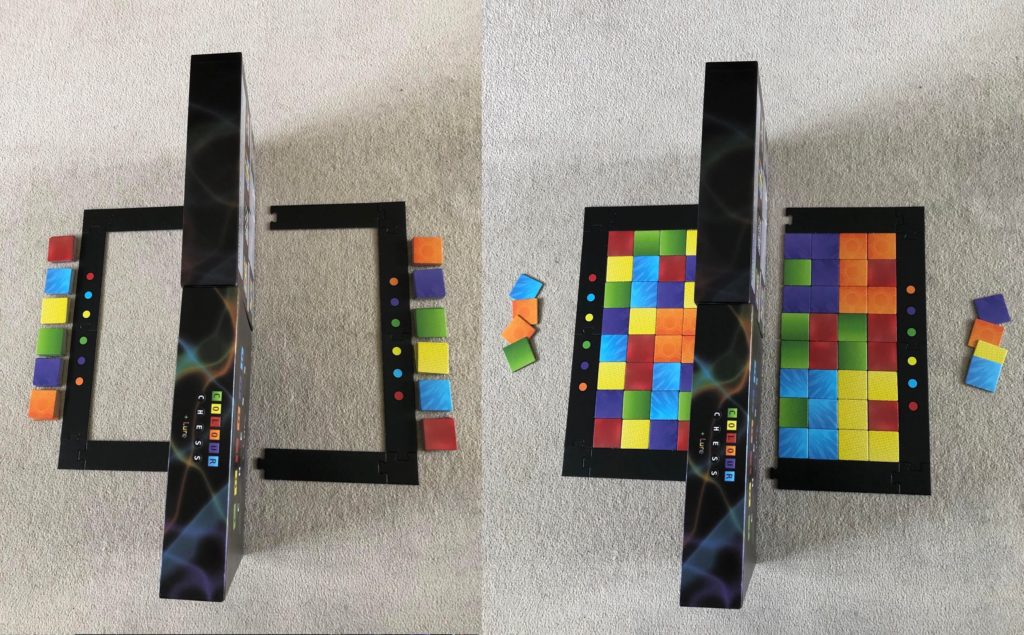There are many variations included in the manual. Here are some additional ones:
Colour Chess – Hidden Setup – MSO 2023
In this setup, tiles are laid out by players individually behind a central screen, to eliminate any unfairness in random colour distribution.
- Build the board frame with a separation in the middle, as shown in the pic below.
- Place the game box or other suitable divider in between the two halves of the board, so that you can’t see the other player’s side.
- Each player takes 6 of each colour tile, totalling 36.
- Players simultaneously fill in their halves of the board using their own tiles (there will be 4 left over each, so there is some flexibility in colour frequency in your board design).
- Remove the divider and carefully slide the halves in and attach the board together.
Colour Chess – Balanced Setup
The setup below ensures that each player has at least two tiles of each colour in their open rows at the start of the game, to prevent potential imbalance in tile distribution.
Black and White each have their own tiles their half of the board, backed with dark and light colours.
Black has 6 x Blue and Purple tiles, 5 x every other colour.
White has 6 x Orange and Yellow tiles, 5 x every other colour.
Setup
Each player:
- Takes their individual tile supply (either White or Black) and sets aside 2 tiles of each colour (totalling 12).
- Shuffles their remaining 20 tiles into a stack, which their opponent then cuts, placing the bottom part on top.
- Lays the first 16 of these 20 tiles into their half of the board, starting at the bottom left and working across to the right, then repeating this for their 2nd row.
- Shuffles their 4 remaining tiles together with their 12 set aside tiles from step 1 into a stack, which their opponent then cuts, placing the bottom part on top.
- Lays these tiles from left to right into their 3rd then 4th rows.
- Adds their playing pieces.
You are ready to play.
Colour Chess – Alternative Setup
A different way of setting up that takes slightly less time than the tournament setup, and ensures at least one of each colour in the front rows.
Each player takes 5 of each colour tile, plus 2 additional tiles (totalling 4 additional tiles between the two players; these should all be different colours). Note that it helps for setting up subsequent games if one player has white-backed tiles, while the other has black-backed.
Each player takes their 32 tiles and randomly places them one at a time into their side of the board in a snake-like fashion, starting at their bottom left corner. (Shuffle your tiles together face-down or draw from a bag). If you pull out the final piece of any one colour before you have finished your first two rows, put it back in the bag (this is to ensure you have at least one of each colour in your 3rd and 4th row).
Starting Player
Not a game variation as such, but something that needs stating:
Black can move first.
In the manual White moves first, as this helps people to understand the game mechanics, building on something they are familiar with. However once you understand how to play the game, either colour can move first.
Bughouse Colour Chess
Bughouse is a great way of playing traditional Chess with 4 players and it works with Colour Chess too (you’ll need two sets).
The rules are exactly the same (read them here), except that you can only drop in captured pieces on the second half of your turn. The colour you drop them onto must be a legal colour choice, as though you were moving to that colour; the opponent then copies that colour as usual.
Stacking Chess / Colour Chess
Plays the same as traditional Chess, except that you are allowed to move your own pieces on top of each other. Can be played on either a traditional or a coloured board.
Once stacked, only the top piece may make a move. If an opponent piece moves onto a stack of yours, only the top piece is captured; the rest remain trapped underneath until the top piece moves away.
You can either play so that players are allowed to remind themselves of what the obscured pieces in the stacks are, or so that once they are covered players must remember what is underneath.
Stacking can be added as an option to other game modes, for example you could play Sequence Colour Chess with the addition of stacking.
Reveal Chess (Action Tiles)
Randomly lay out a Chess board with the coloured side of the tiles face-down.
Play regular Chess with action tiles, but the difference is that after each player’s piece move, they must flip an unoccupied non-coloured tile. The revealed tile’s action properties will now take effect.
You must choose carefully where you want to reveal tiles and weigh up the risks of what might be revealed!
Atomic Colour Chess
Any piece that captures another destroys itself in the process, as well as any non-pawn pieces that are in the surrounding spaces.
The exception to this is the King (which is an adjustment to the normal Atomic Chess rules), who can capture without exploding itself.
This also works well with Swarm!
You can read more about Atomic Chess here.
